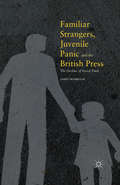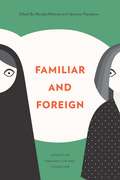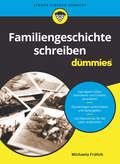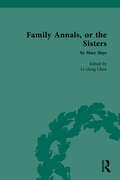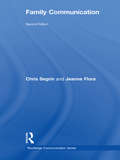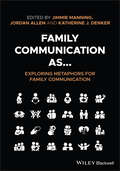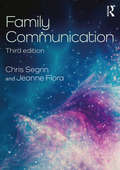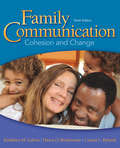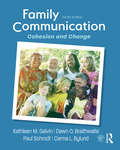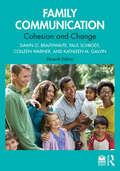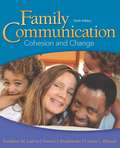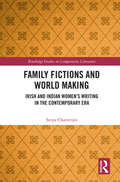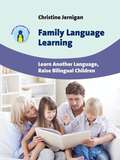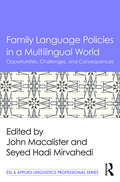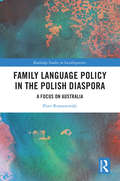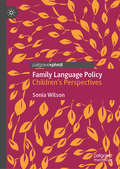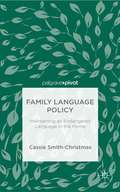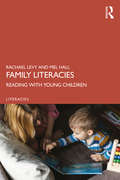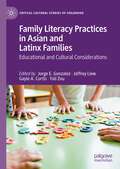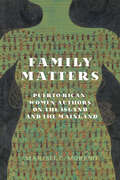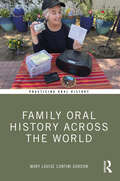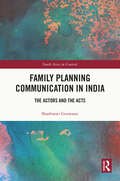- Table View
- List View
Familial Feeling: Entangled Tonalities in Early Black Atlantic Writing and the Rise of the British Novel
by Elahe Haschemi YekaniThis open access book discusses British literature as part of a network of global entangled modernities and shared aesthetic concerns, departing from the retrospective model of a postcolonial “writing back” to the centre. Accordingly, the narrative strategies in the texts of early Black Atlantic authors, like Equiano, Sancho, Wedderburn, and Seacole, and British canonical novelists, such as Defoe, Sterne, Austen, and Dickens, are framed as entangled tonalities. Via their engagement with discourses on slavery, abolition, and imperialism, these texts shaped an understanding of national belonging as a form of familial feeling. This study thus complicates the “rise of the novel” framework and British middle-class identity formation from a transnational perspective combining approaches in narrative studies with postcolonial and queer theory.
Familiar Strangers, Juvenile Panic and the British Press: The Decline of Social Trust
by James MorrisonThis book argues that Britain is gripped by an endemic and ongoing panic about the position of children in society – which frames them as, alternately, victims and threats. It argues the press is a key player in promoting this discourse, which is rooted in a wide-scale breakdown in social trust.
Familiar and Foreign: Identity in Iranian Film and Literature
by Manijeh Mannani Veronica ThompsonThe current political climate of confrontation between Islamist regimes and Western governments has resulted in the proliferation of essentialist perceptions of Iran and Iranians in the West. Such perceptions do not reflect the complex evolution of Iranian identity that occurred in the years following the Constitutional Revolution (1906–11) and the anti-imperialist Islamic Revolution of 1979. Despite the Iranian government’s determined pursuance of anti-Western policies and strict conformity to religious principles, the film and literature of Iran reflect the clash between a nostalgic pride in Persian tradition and an apparent infatuation with a more Eurocentric modernity. In Familiar and Foreign, Mannani and Thompson set out to explore the tensions surrounding the ongoing formulation of Iranian identity by bringing together essays on poetry, novels, memoir, and films. These include both canonical and less widely theorized texts, as well as works of literature written in English by authors living in diaspora. Challenging neocolonialist stereotypes, these critical excursions into Iranian literature and film reveal the limitations of collective identity as it has been configured within and outside of Iran. Through the examination of works by, among others, the iconic female poet Forugh Farrokhzad, the expatriate author Goli Taraqqi, the controversial memoirist Azar Nafisi, and the graphic novelist Marjane Satrapi, author of Persepolis, this volume engages with the complex and contested discourses of religion, patriarchy, and politics that are the contemporary product of Iran’s long and revolutionary history. With contributions by Mostafa Abedinifard, William Anselmi, Blake Atwood, Farideh Dayanim Goldin, Babak Elahi, Goulia Ghardashkani, Manijeh Mannani, Laetitia Nanquette, Safaneh Mohaghesh Neyshabouri, Khatereh Sheibani, Veronica Thompson, Madeleine Voegeli, and Sheena Wilson.
Familiengeschichte schreiben für Dummies (Für Dummies)
by Michaela FrölichMöchten auch Sie Ihre Familiengeschichte niederschreiben und Erlebtes für die Nachwelt bewahren? Dann ist dies das richtige Buch für Sie. Es informiert leicht verständlich, wie Sie Ihre Familienschichten oder Ihre Autobiografie schreiben können. Sie erfahren, was in eine Familiengeschichte hineingehört und was nicht, wie Sie sich an Ihr Leben und das der Familie erinnern können, wie die Inhalte strukturiert und die Erinnerungen aufgeschrieben werden. Anleitungen zum Überarbeiten des Manuskripts sowie für den Umgang mit zukünftigen Lesern runden den Schreibratgeber ab.
Families of the Heart: Surrogate Relations in the Eighteenth-Century British Novel (Transits: Literature, Thought & Culture, 1650-1850)
by Ann CampbellIn this innovative analysis of canonical British novels, Campbell identifies a new literary device—the surrogate family—as a signal of cultural anxieties about young women’s changing relationship to matrimony across the long eighteenth century. By assembling chosen families rather than families of origin, Campbell convincingly argues, female protagonists in these works compensate for weak family ties, explore the world and themselves, prepare for idealized marriages, or sidestep marriage altogether. Tracing the evolution of this rich convention from the female characters in Defoe’s and Richardson’s fiction who are allowed some autonomy in choosing spouses, to the more explicitly feminist work of Haywood and Burney, in which connections between protagonists and their surrogate sisters and mothers can substitute for marriage itself, this book makes an ambitious intervention by upending a traditional trope—the model of the hierarchal family—ultimately offering a new lens through which to regard these familiar works.
Family Annals, or the Sisters: by Mary Hays (Chawton House Library: Women's Novels)
by Li-Ching ChenFamily Annals, or the Sisters, Mary Hays's last novel, was originally published in 1817. This philosophically complex novel examines the themes of the importance of women's education, economic equality of the sexes, and general equality among all human beings. This edition of Family Annals, with a new introduction and editorial commentary by Li-ching Chen, will be of interest to scholars and students of the writing of the Romantic and Victorian eras. It will contribute to various debates about women's education in the nineteenth century, and will provide a new avenue of research in women's writing.
Family Communication (2nd Edition)
by Chris Segrin Jeanne Flora<p>Family Communication carefully examines state-of-the-art research and theories of family communication and family relationships. In addition to presenting cutting-edge research, it focuses on classic theories and research findings that have influenced and revolutionized the way scholars conceptualize family interaction. This text offers a thorough and up-to-date presentation of scientific research in family communication for both teachers and students of family communication as well as professionals who work with families. This second edition features: <p> <li>Chapters updated with the latest research, including over 2000 references. <li>Material on understudied family relationships, such as extended family relationships and gay and lesbian relationships <li>Recent research on understudied topics in family communication, including the influence of technology on mate selection, negotiating work and family stress, single parenting, cohabitation, elder abuse, forgiveness in marriage, and the links among communication, culture, and mental health. <li>A revised chapter on parent-child communication, taking a lifespan perspective that helps organize the large body of research in this area. <li>A new chapter devoted to extended family relationships, with special focus on grandparent-grandchild relationships, in-law relationships, and adult children and their parents. <li>An expanded review of family conflict processes, especially in relation to decision making and power. <p> <p>A companion website provides chapter outlines, exam questions, and PowerPoint slides for students and instructors. Undergraduate readers should find the information easy to understand, while advanced readers, such as graduate students and professionals, will find it a useful reference to classic and contemporary research on family communication and relationships.</p>
Family Communication as... Exploring Metaphors for Family Communication
by Jimmie Manning Jordan Allen Katherine J. DenkerAn innovative textbook that presents a novel and compelling examination of family communication studies Family Communication as… Exploring Metaphors for Family Communication presents a series of metaphors through which students explore the nuances and complexities of family interaction. With a unique approach to the foundational theories and real-world practices of family communication, this easily accessible textbook helps students develop a clear understanding of what family communication is and what it can be. Contributions by both prominent and newer scholars theorize about family communication, offer new perspectives, challenge long-held assumptions, and describe original research to provide students with an up-to-date representation of the leading thinking in the field. Each concise chapter focuses on a specific element of family life, engaging key metaphors to stimulate classroom discussion about family in contexts ranging from ritual and embodiment to estrangement and heteronormativity. Throughout the text, students examine family metaphorically—as memory, as social identity, as estrangement, as loss, as resilience, as raced, and more. Presents a metaphorical examination of creating, materializing, contextualizing, politicizing, and complicating family communication Offers an innovative alternative to standard textbooks on the subject Features a thorough introduction advocating for the use of metaphors in teaching Discusses the key topics and theoretical approaches that have defined the field Includes detailed references, additional readings, and an instructor&’s companion website Family Communication as… Exploring Metaphors for Family Communication is an excellent textbook for advanced undergraduate and graduate students in courses including family communication, family studies, interpersonal communication, relational communication, and communication theory. It is also a highly useful resource for scholars in fields such as media studies, psychology, sociology, social work, counseling, and public health.
Family Communication: Chris Segrin (Routledge Communication Series)
by Chris Segrin Jeanne FloraFamily Communication carefully examines state-of-the-art research and theories of family communication and family relationships. In addition to presenting contemporary cutting-edge research, it also includes extensive presentation and application of classic theories and findings in family science that have informed current day understandings of essential family processes. This text represents a current and comprehensive presentation of information generated by principled research conducted throughout the world for both students and teachers of family communication, as well as for professionals who work with families and seek an evidence-based understanding of functional and dysfunctional family processes. New to the third edition is an expanded coverage of understudied family relationships and diverse family forms. Each chapter is carefully updated to include important new research findings generated over the past seven years (e.g., communication in families coping with military deployment, adoption, and same sex or transgender parents). The text is also accompanied by a companion website that provides additional resources for students: extended case studies relevant to various topics and chapters in the book a media guide with links to videos and other media relevant to certain topics covered in the book an additional chapter for understanding different family communication research methods) For instructors, the companion website offers: an extensive bank of discussion and test questions
Family Communication: Cohesion and Change
by Dawn O. Braithwaite Kathleen M. Galvin Carma L. BylundFamily Communication: Cohesion and Change encourages students to observe family interaction patterns analytically and relate communication theories to family interactions. Using a framework of family functions, first-person narratives, and current research, Family Communication: Cohesion and Change emphasizes the diversity of today's families in terms of structure, ethnic patterns, and developmental experiences.
Family Communication: Cohesion and Change
by Dawn O. Braithwaite Kathleen M. Galvin Paul Schrodt Carma L. BylundFamily Communication: Cohesion and Change encourages students to think critically about family interaction patterns and to analyze them using a variety of communication theories. Using a framework of family functions, current research, and first-person narratives, this text emphasizes the diversity of today's families in structure, ethnic patterns, gender socialization, and developmental experiences. New for the tenth edition are expanded pedagogical features to improve learning and retention, as well as updates on current theory and research integrated throughout the chapters for timely analysis and discussion. Cases and research featured in each chapter provide examples of concepts and themes, and a companion website offers expanded resources for instructors and students. On the book's companion website, www.routledge.com/cw/galvin, intstructors will find a full suite of online resources to help build their courses and engage their students, as well as an author video introducing the new edition: Course Materials Syllabi & Suggested Calendars Course Projects & Paper Examples Essay Assignments Test/Quiz Questions and Answer Keys Case Studies in Family Communication Family Communication Film and Television Examples Family Communication in Literature Examples Chapter Outlines Detailed Outlines Discussion Questions Case Study Questions Sample Chapter Activities Chapter PowerPoint Slides
Family Communication: Cohesion and Change
by Dawn O. Braithwaite Kathleen M. Galvin Paul Schrodt Colleen WarnerNow in its eleventh edition, Family Communication: Cohesion and Change continues to provide students with a foundational, accessible, and inclusive overview of the family communication field.The eleventh edition represents the plurality of today’s families, helping students see themselves and think through how the up-to-date research and theory apply to their lives. It features a more concise narrative with streamlined key concepts that are more straightforward and engaging for students. Now presented in three sections, Communication and Family Lenses, Communication and Family Cohesion, and Communication and Family Adaptability, this edition’s new features include learning objectives for each chapter, Family Portrait interviews with top scholars, a glossary of key definitions, and expanded Family Reflections discussion questions interspersed in the text.This book is ideal for undergraduate courses in family communication, allied subjects in communication studies, family studies, nursing, and social work programs.The accompanying Instructor and Student Resources provide free digital materials designed to test students’ knowledge and save instructor time when preparing lessons. Please visit www.routledgelearning.com/familycommunication for interactive activities, practice quizzes, and more.
Family Communication: Cohesion and Change
by Kathleen M. Galvin Dawn O. Braithwaite Carma L. BylundAddresses the role of communication in developing and maintaining functional, diverse family relationships Family Communication: Cohesion and Change encourages students to observe family interaction patterns analytically and relate communication theories to family interaction Using a framework of family functions, first-person narratives, and current research, Family Communication: Cohesion and Change emphasizes the diversity of today's families in terms of structure, ethnic patterns, and developmental experiences. MySearchLab is a part of the Galvin/Bylund/Braithwaite program. Research and writing tools, including access to academic journals, help students understand critical thinking in even greater depth. To provide students with flexibility, students can download the eText to a tablet using the free Pearson eText app. Note: this is the standalone book, if you want the book/access card order the ISBN below: 0133814998 / 9780133814996 Family Communication: Cohesion and Change plus MySearchLab with eText -- Access Card Package Package consists of: 0205239927 / 9780205239924 MySearchLab with Pearson eText -- Valuepack Access Card 0205945236 / 9780205945238 Family Communication: Cohesion and Change
Family Fictions and World Making: Irish and Indian Women’s Writing in the Contemporary Era (Routledge Studies in Comparative Literature)
by Sreya ChatterjeeFamily Fictions and World Making: Irish and Indian Women’s Writing in the Contemporary Era is the first book-length comparative study of family novels from Ireland and India. On the one hand, despite an early as well as late colonial experience, Ireland is often viewed exclusively within a metropolitan British and Europe-centered frame. India, on the other hand, once seen as a model of decolonization for the non-Western world, has witnessed a crisis of democracy in recent years. This book charts the idea of "world making" through the fraught itineraries of the Irish and the Indian family novel. The novels discussed in the book foreground kinship based on ideological rather than biological ties and recast the family as a nucleus of interests across national borders. The book considers the work of critically acclaimed women authors Anne Enright, Elizabeth Bowen, Mahasweta Devi, Jennifer Johnston, Kiran Desai and Molly Keane. These writers are explored as representative voices for the interwar years, the late-modern period, and the globalization era. They not only push back against the male nationalist idiom of the family but also successfully interrogate family fiction as a supposedly private genre. The broad timeframe of Family Fictions and World Making from the interwar period to the globalization era initiates a dialogue between the early and the current debates around core and periphery in postcolonial literature.
Family History Digital Libraries
by William Sims BainbridgeIn the modern era, every family and local community can cultivate its own history, endowing living people with meanings inherited from the people of the past, by means of today’s computer-based information and communication technologies. A new profession is emerging, family historians, serving the wider public by assisting in collection and analysis of fascinating data, by teaching talented amateur historians, and by producing complete narratives. Essential are the skills and technologies required to preserve and connect photos, movies, videos, diaries, memoirs, correspondence, artefacts and even architecture such as homes. Online genealogical services are well established sources of official government records, but usually not for recent decades, and not covering the valuable records of legal, medical, and religious organizations. Information can be shared and interpreted by family members through oral history interviews, social media, and online private archives such as wikis and shared file depositories. This book explores a wide variety of online information sources and achieves coherence by documenting and interpreting the history of a particular extended American family on the basis of 9 decades of movies and videos, 17 decades of photographs, and centuries of documents. Starting now, any family may begin to preserve their current experiences for the historians of the future, but this will require social as well as technical innovations. This book is the essential resource, providing the fundamental principles, effective methods, and fascinating questions required to make our past live again.
Family Language Learning
by Christine JerniganFamily Language Learning is a practical guide designed to support, advise and encourage any parents who are hoping to raise their children bilingually. It is unique in that it focuses on parents who are not native speakers of a foreign language. It gives parents the tools they need to cultivate and nurture their own language skills while giving their children an opportunity to learn another language. The book combines cutting-edge research on language exposure with honest and often humorous stories from personal interviews with families speaking a foreign language at home. By dispelling long-held myths about how language is learned, it provides hope to parents who want to give their children bilingual childhoods, but feel they don't know where to start with learning foreign languages.
Family Language Policies in a Multilingual World: Opportunities, Challenges, and Consequences (ESL & Applied Linguistics Professional Series)
by John Macalister Seyed Hadi MirvahediThrough case studies from around the world, this book illustrates the opportunities and challenges facing families negotiating the issues of language maintenance and language learning in the home. Every family living in a bi/multilingual environment faces the question of what language(s) to speak with their children and must make a decision, consciously or otherwise, about these issues. Exploring links between language policy in the home and wider society in a range of diverse settings, the contributors utilize various research tools, including interviews, questionnaires, observations, and archival document analysis, to explore linguistic ideologies and practices of family members in the home, illuminating how these are shaped by macro-level societal processes.
Family Language Policy in the Polish Diaspora: A Focus on Australia (Routledge Studies in Sociolinguistics)
by Piotr RomanowskiThis book explores language practices, beliefs and management across a group of Polish immigrant families in Australia, drawing on these case studies as a lens through which to unpack dynamics of Family Language Policy (FLP) and their implications for future research on FLP. The volume begins by outlining the historical context of Polish immigration in Australia, charting two key waves of Polish migration in the 20th century and the subsequent unfolding of issues around language and culture maintenance in these families. This discussion paves the way for exploring key themes of language socialization, language ideologies and heritage language maintenance and the affordances of FLP research in elucidating these dynamics at work in the lived experiences of a group of Polish immigrant families in Melbourne. The book highlights the importance of a triangulated approach, integrating qualitative and quantitative methods, in offering nuanced insights into parental approaches and children’s experiences of a bilingual upbringing and the wider impact of FLP on transnational families. Opening up avenues for future research on Family Language Policy and a better understanding of the language practices of specific communities in a globalised world, this book will be of interest to scholars in multilingualism, sociolinguistics and applied linguistics.
Family Language Policy: Children’s Perspectives
by Sonia WilsonThis book explores the question of family language policy in multilingual households. Presenting six case studies which focus on the experiences of parents and children in French-English bilingual contexts, the author draws conclusions about the impact of parental language management on the family as a whole which can be applied to transnational families from other linguistic backgrounds. While many parental guides on bilingual childrearing have been published in recent years, little attention has been paid to the possible impact of such language strategies on the experiences and interrelationships of bilingual family members. This book is unique in focusing in depth on the psychology and experiences of the child, and it will be of interest to readers in fields as diverse as sociolinguistics, language policy and planning, sociology of youth and family, and child psychology.
Family Literacies: Reading with Young Children (Literacies)
by Rachael Levy Mel HallFamily Literacies demonstrates, through reference to empirical research, how shared reading practices operate in a wide range of families, with a view to supporting families in reading with their pre-school children. At the heart of this book, written by two highly experienced experts in the field, is a fascinating project that captured diverse voices, and experiences by parents, children and other family members. Rachael Levy and Mel Hall deploy a rich and distinctive theoretical framework, drawing on insights from literacy studies, education and sociology. Family Literacies presents an account of shared reading practices in homes, focusing attention on what motivates parents to read with their children as well as revealing what parents may need if they are to begin and sustain shared reading activity. The authors show the many ways in which reading is centrally embedded in many aspects of family life, arguing that this has particular implications for children as they start school. Situated within a socio-cultural discourse, this book explains why it is important to understand how and why shared reading takes place in homes so that all families can be supported in reading with their children. Family Literacies is essential reading for all those who are studying and researching literacy practices, especially those involving young children. The book will also be of value to students, practitioners and researchers in education and applied linguistics who are working with families and have an interest in the study of family practices. The authors’ findings have major implications for how parents can be encouraged to develop positive reading relationships with their children.
Family Literacy Practices in Asian and Latinx Families: Educational and Cultural Considerations (Critical Cultural Studies of Childhood)
by Jeffrey Liew Gayle A. Curtis Yali Zou Jorge E. GonzalezThis book focuses on the literacy beliefs and practices of parents and children from Asian and Latinx heritage backgrounds. In the US, children from Asian and Latinx immigrant backgrounds represent the largest population of dual language learners in schools. While existing research has paid significant attention to the roles of parenting and the home literacy environment on children's literacy development, relatively little attention has been allocated to immigrant families. Chapters aim to meet the need in the field to understand the roles of culture and immigrant experiences on children's literacy learning and development, including immigrant families' home environments and parents' involvement in literacy-related activities in both English and the parents' native language. As Hispanic/Latinx and Asian American populations grow in the US, this book answers an urgent call for school systems and child and family professionals to be aware of issues in this area and how to address them in culturally responsive ways.
Family Matters: Puerto Rican Women Authors on the Island and the Mainland (New World Studies)
by Marisel C. MorenoAdopting a comparative and multidisciplinary approach to Puerto Rican literature, Marisel Moreno juxtaposes narratives by insular and U.S. Puerto Rican women authors in order to examine their convergences and divergences. By showing how these writers use the trope of family to question the tenets of racial and social harmony, an idealized past, and patriarchal authority that sustain the foundational myth of la gran familia, she argues that this metaphor constitutes an overlooked literary contact zone between narratives from both sides. Moreno proposes the recognition of a "transinsular" corpus to reflect the increasingly transnational character of the Puerto Rican population and addresses the need to broaden the literary canon in order to include the diaspora. Drawing on the fields of historiography, cultural studies, and gender studies, the author defies the tendency to examine these literary bodies independently of one another and therefore aims to present a more nuanced and holistic vision of this literature.
Family Oral History Across the World (Practicing Oral History)
by Mary Louise Contini GordonFamily Oral History Across the World presents a process for memorializing family histories, bringing together established oral history standards, exploratory research, and narrative data analysis. Based on and using a prequestionnaire and over 40 recorded interviews with people from across six continents, the analysis system used in the book presents material from these interviews that brings alive the experience of the family history journey. One of the guiding principles is to encourage readers to interview family members, but also others outside the family unit, and to produce a family history in whatever format works. The book illustrates this through the inclusion of many unusual formats and stories uncovered. The book is divided into a number of themes that emerged through the analysis of numerical questionnaire and narrative interview data. Parts I, II, and III cover changing family demography, case studies, and factors such as memory, emotion, and ethics. Part IV offers a pliable process and practice guide with input and examples from interviews. It also discusses developing approaches to presenting oral histories from both oral historians and other interviewers and writers, such as journalists. With case studies as well as example guidelines and templates, this volume is ideal both for academics interested in family history as well as professional genealogists and families themselves.
Family Planning Communication in India: The Actors and the Acts (South Asia in Context)
by Shashwati GoswamiThis book is the first systematic study on the historiography of the family planning communication process in India. It traces the history of the development of a highly technical health communication process. It discusses how the discourse on India’s population problem was at the heart of the development dialogue which was being promoted by the British colonial administration. The book examines the role of the censuses and the Five-Year plans in the development of the discussion on the population ‘explosion’ in India. Also, it critically discusses the role of the Ford Foundation’s leadership in institutionalising the communication process in India. The book essentially argues that population control communication enabled the ideas of a homogenised nation, an 'ideal' Indian woman and an ‘ideal’ Indian family. This, in turn, led to the obliteration of cultural, ethnic, geographical and economic specificities of India as a country. The volume will be of great interest to scholars and researchers of public policy, media and communication studies, Indian politics, modern Indian history and South Asian Studies.

